Depositional Structures and Their Reservoir Characteristics in the Wufeng–Longmaxi Shale in Southern Sichuan Basin, China
Abstract
:1. Introduction
2. Geological Setting
3. Samples and Methods
3.1. Sampling and Imaging
3.2. Organic Geochemistry
3.3. Sedimentary Petrography
3.3.1. Thin Sections and X-ray Diffraction Analysis
3.3.2. Scanning Electron Microscopy and Pore Analysis
3.3.3. Helium Porosity and Permeability
3.3.4. Major and Trace Element Analysis and Sedimentation Rate
4. Results
4.1. Layering
4.2. Depositional Structures
4.2.1. Paper Lamination (PL)
4.2.2. Grading Lamination Composed of Claystone (GL-C)
4.2.3. Grading Lamination Composed of Siltstone and Claystone (GL-SC)
4.2.4. Interlaminated Lamination Composed of Siltstone and Claystone (IL)
4.2.5. Structureless Beds (SB)
4.3. Geochemical Parameters and Sedimentation Rate
4.3.1. Geochemical Parameters
4.3.2. Sedimentation Rate
4.4. Fractures and Microfractures
4.5. Nanopores and Porosity Distribution
4.6. Physical Properties
4.6.1. Porosity Distribution
4.6.2. Permeability
5. Discussion
5.1. Climatic Condition and Paleoredox Condition
5.2. Genesis of Various Depositional Structures
5.3. Influence of Depositional Structures on Porosity and Permeability
5.3.1. Porosity
5.3.2. Permeability
5.4. Influence of Depositional Structures on Target Shale
5.5. Future Research
6. Conclusions
Author Contributions
Funding
Institutional Review Board Statement
Informed Consent Statement
Data Availability Statement
Conflicts of Interest
Appendix A
| Depositional Structures | Sample | Quartz/% | Potash Feldspar/% | Plagioclase/% | Calcite/% | Dolomite/% | Pyrite/% | Clay Minerals/% | TOC/% |
|---|---|---|---|---|---|---|---|---|---|
| PL | 8-7-1 | 65.00 | 1.00 | 2.80 | 4.80 | 8.60 | 0.00 | 16.60 | 10.00 |
| PL | 8-8-1 | 70.90 | 1.30 | 2.50 | 2.40 | 6.90 | 0.00 | 16.00 | 9.10 |
| PL | 8-8-2 | 59.00 | 0.00 | 4.00 | 2.60 | 8.70 | 2.50 | 21.70 | 10.00 |
| PL | 8-9-1 | 71.20 | 0.00 | 2.80 | 1.70 | 8.10 | 0.00 | 16.20 | 12.00 |
| PL | 8-10-1 | 73.40 | 0.00 | 1.90 | 1.60 | 6.30 | 1.70 | 15.10 | 11.00 |
| PL | 8-10-2 | 68.10 | 0.00 | 2.50 | 2.40 | 8.20 | 1.50 | 17.30 | 9.60 |
| PL | 8-11-1 | 73.80 | 0.00 | 2.30 | 1.30 | 6.10 | 3.20 | 14.00 | 10.00 |
| PL | 8-12-1 | 70.80 | 0.00 | 2.50 | 1.90 | 6.60 | 1.90 | 15.00 | 11.00 |
| PL | 8-12-2 | 71.10 | 0.00 | 3.10 | 1.20 | 6.70 | 1.60 | 16.30 | 9.10 |
| PL | 8-13-1 | 72.60 | 2.20 | 2.00 | 0.00 | 5.40 | 1.70 | 16.10 | 9.60 |
| PL | 8-14-1 | 69.60 | 0.00 | 1.90 | 2.40 | 9.00 | 3.30 | 13.80 | 9.30 |
| PL | 8-14-2 | 65.00 | 0.00 | 1.70 | 3.10 | 12.60 | 1.50 | 15.40 | 8.70 |
| PL | 8-31-1 | 75.30 | 0.00 | 2.00 | 0.00 | 5.80 | 0.00 | 16.90 | 7.60 |
| Average | 69.68 | 0.35 | 2.46 | 1.95 | 7.62 | 1.45 | 16.18 | 9.77 | |
| GL-C | 4-2-1 | 25.00 | 0.00 | 0.00 | 27.00 | 34.00 | 2.20 | 12.00 | 2.70 |
| GL-C | 4-2-2 | 28.30 | 0.00 | 0.00 | 25.20 | 33.10 | 1.90 | 11.50 | 2.70 |
| GL-C | 4-3-1 | 30.00 | 0.00 | 0.00 | 25.00 | 35.00 | 0.00 | 10.00 | 2.50 |
| GL-C | 4-3-2 | 27.00 | 0.00 | 2.00 | 24.00 | 35.00 | 2.00 | 10.00 | 2.40 |
| GL-C | 4-4-1 | 33.00 | 0.00 | 1.40 | 19.20 | 34.20 | 1.20 | 11.70 | 2.50 |
| GL-C | 4-6-1 | 37.00 | 0.70 | 0.70 | 20.00 | 27.00 | 1.50 | 12.40 | 3.30 |
| GL-C | 4-7-1 | 40.00 | 0.00 | 0.00 | 19.70 | 26.40 | 1.20 | 12.70 | 3.60 |
| GL-C | 4-8-1 | 33.00 | 0.00 | 1.40 | 28.20 | 16.40 | 1.00 | 21.10 | 4.00 |
| GL-C | 4-10-1 | 42.00 | 0.00 | 0.00 | 24.70 | 19.40 | 1.20 | 12.70 | 3.70 |
| GL-C | 4-11-1 | 47.00 | 0.00 | 0.90 | 23.10 | 16.00 | 0.90 | 12.10 | 2.80 |
| GL-C | 4-12-1 | 41.80 | 0.00 | 1.00 | 24.40 | 19.10 | 1.20 | 12.50 | 3.00 |
| GL-C | 4-13-1 | 42.00 | 1.00 | 0.80 | 22.60 | 19.90 | 1.10 | 11.50 | 3.40 |
| GL-C | 4-16-1 | 37.40 | 0.70 | 0.90 | 18.60 | 25.80 | 2.40 | 14.20 | 3.10 |
| GL-C | 4-18-1 | 55.90 | 0.00 | 1.10 | 14.00 | 13.10 | 1.50 | 14.40 | 4.10 |
| GL-C | 4-19-1 | 40.70 | 1.10 | 1.30 | 22.70 | 16.00 | 2.20 | 16.00 | 3.20 |
| GL-C | 4-19-2 | 51.00 | 0.00 | 1.00 | 22.10 | 9.50 | 1.60 | 14.30 | 4.60 |
| GL-C | 4-20-1 | 58.00 | 0.00 | 0.00 | 19.00 | 8.50 | 0.90 | 12.50 | 2.60 |
| GL-C | 4-21-1 | 51.00 | 0.00 | 0.90 | 21.90 | 10.70 | 0.00 | 14.50 | 3.50 |
| GL-C | 4-22-1 | 47.00 | 0.00 | 1.40 | 22.00 | 17.90 | 0.00 | 11.70 | 3.00 |
| GL-C | 4-24-1 | 50.00 | 1.20 | 0.80 | 19.10 | 14.50 | 1.80 | 12.00 | 3.10 |
| GL-C | 4-25-1 | 55.30 | 0.00 | 0.00 | 16.70 | 14.80 | 0.00 | 13.20 | 3.20 |
| GL-C | 4-27-1 | 58.00 | 0.00 | 1.10 | 17.80 | 9.20 | 1.50 | 11.70 | 3.10 |
| GL-C | 4-27-2 | 57.10 | 0.00 | 1.00 | 18.70 | 10.50 | 1.40 | 11.30 | 3.90 |
| GL-C | 4-28-1 | 54.00 | 0.00 | 0.90 | 15.60 | 11.70 | 1.70 | 14.90 | 3.90 |
| GL-C | 4-31-1 | 58.00 | 0.00 | 1.60 | 11.60 | 9.50 | 1.00 | 16.50 | 4.40 |
| GL-C | 4-32-1 | 71.00 | 0.00 | 1.20 | 6.30 | 7.20 | 0.00 | 15.00 | 4.20 |
| GL-C | 4-36-1 | 65.30 | 0.00 | 1.70 | 8.00 | 10.60 | 0.00 | 14.40 | 4.30 |
| GL-C | 4-36-2 | 60.00 | 0.00 | 1.10 | 16.10 | 9.20 | 1.90 | 12.40 | 3.70 |
| GL-C | 4-40-1 | 33.50 | 1.30 | 2.60 | 21.00 | 17.00 | 0.80 | 23.10 | 3.90 |
| GL-C | 5-5-1 | 52.80 | 0.00 | 0.90 | 22.40 | 9.00 | 2.10 | 12.80 | 4.10 |
| GL-C | 5-5-2 | 48.00 | 0.00 | 1.30 | 25.80 | 10.60 | 0.00 | 13.70 | 3.90 |
| GL-C | 5-6-1 | 47.30 | 0.00 | 1.20 | 25.00 | 10.40 | 0.00 | 17.20 | 4.70 |
| GL-C | 5-8-1 | 50.00 | 0.00 | 1.10 | 25.70 | 9.80 | 0.00 | 12.90 | 1.70 |
| GL-C | 5-12-1 | 44.00 | 0.00 | 1.20 | 31.10 | 9.60 | 0.00 | 13.60 | 5.00 |
| GL-C | 5-19-1 | 41.00 | 0.80 | 0.80 | 31.10 | 13.20 | 1.30 | 12.40 | 4.00 |
| GL-C | 5-20-1 | 42.00 | 0.00 | 0.90 | 30.00 | 10.70 | 1.60 | 14.30 | 4.00 |
| GL-C | 5-21-1 | 36.10 | 0.00 | 0.80 | 33.40 | 13.10 | 1.90 | 14.70 | 4.30 |
| GL-C | 5-22-1 | 43.00 | 0.00 | 0.90 | 32.50 | 9.40 | 2.00 | 12.20 | 5.20 |
| GL-C | 5-22-2 | 40.60 | 0.00 | 0.90 | 35.30 | 9.30 | 2.50 | 11.40 | 4.70 |
| GL-C | 5-23-1 | 33.70 | 0.00 | 3.00 | 32.00 | 12.20 | 5.60 | 12.80 | 4.40 |
| GL-C | 5-24-1 | 36.10 | 0.00 | 0.90 | 34.20 | 13.70 | 2.20 | 12.90 | 4.40 |
| GL-C | 5-24-2 | 38.50 | 0.00 | 0.90 | 31.00 | 12.60 | 3.40 | 12.80 | 3.90 |
| GL-C | 5-25-1 | 32.40 | 0.70 | 1.00 | 32.30 | 16.60 | 2.40 | 14.60 | 4.00 |
| GL-C | 5-26-1 | 40.00 | 0.00 | 1.10 | 32.40 | 12.60 | 1.30 | 13.40 | 4.50 |
| GL-C | 5-26-2 | 39.00 | 0.70 | 0.90 | 32.70 | 12.10 | 1.60 | 11.80 | 4.10 |
| GL-C | 5-27-1 | 40.50 | 1.40 | 1.00 | 31.00 | 11.90 | 1.90 | 11.60 | 4.10 |
| GL-C | 5-28-1 | 35.90 | 0.60 | 1.10 | 38.00 | 10.40 | 1.60 | 12.40 | 3.40 |
| GL-C | 5-29-1 | 37.40 | 0.00 | 1.00 | 36.10 | 12.10 | 1.70 | 11.70 | 4.10 |
| GL-C | 5-29-2 | 32.00 | 0.70 | 1.00 | 37.00 | 14.00 | 2.60 | 12.10 | 5.50 |
| GL-C | 5-30-1 | 38.10 | 0.00 | 1.10 | 35.00 | 13.10 | 2.00 | 11.40 | 6.60 |
| GL-C | 5-30-2 | 26.50 | 0.00 | 2.40 | 33.00 | 20.60 | 2.10 | 14.90 | 6.20 |
| GL-C | 5-31-1 | 27.80 | 0.00 | 0.90 | 23.00 | 18.30 | 18.30 | 12.30 | 7.50 |
| GL-C | 5-35-1 | 34.70 | 1.00 | 4.20 | 21.90 | 17.60 | 3.20 | 17.40 | 7.30 |
| GL-C | 5-35-2 | 32.10 | 0.00 | 4.80 | 20.00 | 12.20 | 4.50 | 26.40 | 7.80 |
| GL-C | 5-35-3 | 31.30 | 0.70 | 4.40 | 18.70 | 11.20 | 2.20 | 31.50 | 7.90 |
| GL-C | 5-35-4 | 36.10 | 1.10 | 5.20 | 20.90 | 10.00 | 2.30 | 25.10 | 7.70 |
| GL-C | 6-2-1 | 36.40 | 0.00 | 5.40 | 18.30 | 14.70 | 2.60 | 22.60 | 7.50 |
| GL-C | 6-3-1 | 38.00 | 0.00 | 5.70 | 17.00 | 10.70 | 5.30 | 22.70 | 6.80 |
| GL-C | 6-4-1 | 35.10 | 1.30 | 6.50 | 19.40 | 13.60 | 3.30 | 20.80 | 8.30 |
| GL-C | 6-5-1 | 37.00 | 1.30 | 6.50 | 18.50 | 11.20 | 3.70 | 20.90 | 7.80 |
| GL-C | 6-5-2 | 36.40 | 1.10 | 6.50 | 21.10 | 13.00 | 3.80 | 18.10 | 8.00 |
| GL-C | 6-7-1 | 34.30 | 1.70 | 6.20 | 20.80 | 14.70 | 4.00 | 18.30 | 7.20 |
| GL-C | 6-7-2 | 34.80 | 2.70 | 6.20 | 21.60 | 13.20 | 4.10 | 17.40 | 6.40 |
| GL-C | 6-12-1 | 32.70 | 1.20 | 7.00 | 23.70 | 14.00 | 4.20 | 16.60 | 6.60 |
| GL-C | 6-16-1 | 29.00 | 1.40 | 6.80 | 27.20 | 15.10 | 4.20 | 17.20 | 6.40 |
| Average | 41.23 | 0.38 | 1.98 | 24.05 | 15.20 | 2.15 | 14.88 | 4.59 | |
| GL-SC | 8-6-1 | 39.70 | 1.00 | 3.20 | 10.00 | 13.40 | 1.70 | 31.00 | 10.00 |
| GL-SC | 8-6-2 | 50.10 | 1.30 | 3.00 | 8.10 | 16.70 | 2.40 | 19.20 | 10.00 |
| GL-SC | 9-1-1 | 59.00 | 0.00 | 2.50 | 12.70 | 7.60 | 1.20 | 16.40 | 7.60 |
| GL-SC | 9-15-1 | 58.00 | 0.00 | 1.80 | 12.80 | 9.60 | 2.10 | 15.00 | 5.00 |
| GL-SC | 9-18-1 | 52.90 | 0.00 | 2.20 | 15.60 | 13.00 | 1.90 | 14.40 | 6.10 |
| Average | 51.94 | 0.46 | 2.54 | 11.84 | 12.06 | 1.86 | 19.20 | 7.74 | |
| IL | 9-1-1 | 41.60 | 1.00 | 3.10 | 19.30 | 17.20 | 2.50 | 15.30 | 5.60 |
| IL | 9-2-1 | 49.00 | 1.30 | 3.00 | 21.10 | 9.70 | 1.10 | 14.80 | 6.20 |
| IL | 9-3-1 | 48.90 | 0.80 | 2.20 | 22.00 | 11.40 | 1.10 | 13.60 | 6.40 |
| IL | 9-5-1 | 50.90 | 0.90 | 1.80 | 18.00 | 12.90 | 1.80 | 12.70 | 4.30 |
| IL | 9-16-2 | 46.70 | 1.10 | 1.40 | 19.70 | 16.20 | 1.70 | 13.20 | 3.90 |
| IL | 9-19-2 | 32.40 | 0.00 | 2.80 | 28.50 | 20.40 | 2.30 | 13.60 | 4.20 |
| IL | 10-7-1 | 40.70 | 0.90 | 3.00 | 21.90 | 16.90 | 2.40 | 13.60 | 5.00 |
| IL | 10-11-1 | 42.00 | 0.00 | 2.10 | 23.50 | 15.10 | 3.20 | 14.10 | 4.50 |
| IL | 10-14-1 | 40.80 | 1.50 | 3.30 | 19.30 | 20.00 | 2.10 | 13.00 | 4.30 |
| Average | 43.67 | 0.83 | 2.52 | 21.48 | 15.53 | 2.02 | 13.77 | 4.93 | |
| SM | 5-31-1 | 32.80 | 0.00 | 1.00 | 24.90 | 20.30 | 10.10 | 10.90 | 5.60 |
| SM | 5-32-1 | 33.40 | 0.00 | 2.90 | 27.70 | 17.70 | 6.20 | 12.10 | 7.00 |
| SM | 5-32-2 | 25.90 | 0.00 | 1.40 | 29.50 | 26.80 | 5.10 | 10.90 | 6.60 |
| SM | 5-32-3 | 16.00 | 0.00 | 2.20 | 31.30 | 36.90 | 3.20 | 10.70 | 6.30 |
| SM | 5-33-2 | 29.80 | 0.00 | 2.30 | 32.50 | 21.00 | 4.00 | 10.40 | 7.30 |
| SM | 5-33-3 | 20.40 | 0.00 | 3.00 | 31.10 | 30.60 | 5.10 | 9.80 | 6.00 |
| SM | 5-33-4 | 14.50 | 0.00 | 2.60 | 32.90 | 38.00 | 4.00 | 7.30 | 7.00 |
| SM | 5-34-1 | 14.30 | 0.00 | 2.80 | 42.10 | 30.40 | 2.90 | 7.50 | 7.60 |
| SM | 5-34-3 | 20.30 | 0.00 | 2.20 | 34.10 | 32.80 | 2.10 | 8.50 | 7.10 |
| SM | 5-34-4 | 25.90 | 0.00 | 2.80 | 31.60 | 27.40 | 2.30 | 10.00 | 7.50 |
| SM | 6-19-1 | 22.80 | 0.80 | 4.00 | 33.00 | 16.30 | 1.90 | 20.50 | 6.00 |
| SM | 6-19-2 | 23.10 | 1.00 | 5.10 | 34.70 | 16.00 | 2.90 | 17.20 | 5.90 |
| SM | 6-22-1 | 22.70 | 0.80 | 5.00 | 31.60 | 15.20 | 2.20 | 21.80 | 5.90 |
| SM | 7-1-1 | 23.60 | 1.20 | 4.10 | 33.50 | 14.90 | 3.30 | 19.40 | 4.90 |
| SM | 7-1-2 | 21.80 | 0.70 | 4.80 | 32.00 | 17.30 | 6.40 | 17.00 | 4.00 |
| SM | 7-4-1 | 24.70 | 0.60 | 3.30 | 32.00 | 18.40 | 4.70 | 15.60 | 2.40 |
| SM | 7-4-2 | 24.60 | 0.90 | 7.00 | 26.90 | 17.80 | 5.30 | 16.50 | 2.00 |
| SM | 8-4-1 | 36.00 | 0.00 | 1.80 | 29.30 | 18.30 | 2.10 | 12.50 | 11.00 |
| Average | 35.12 | 0.55 | 3.05 | 26.23 | 16.28 | 3.25 | 15.38 | 5.99 | |
| Depositional Structures | Section | Stage | Formation | Graptolite Zone | Sample Number | Depth/m | CIA | U/Th | Ni/Co | V/Cr |
|---|---|---|---|---|---|---|---|---|---|---|
| IL | YS 103 | Aeronian | Longmaxi | LM6-9 | YS103-001 | 1026.19 | 64.53 | 0.279 | 2.750 | 1.451 |
| IL | YS 103 | Aeronian | Longmaxi | LM6-9 | YS103-002 | 1031.30 | 62.03 | 0.288 | 3.292 | 1.337 |
| IL | YS 103 | Aeronian | Longmaxi | LM6-9 | YS103-003 | 1033.76 | 62.78 | 0.281 | 3.326 | 1.343 |
| IL | YS 103 | Aeronian | Longmaxi | LM6-9 | YS103-004 | 1036.24 | 63.91 | 0.278 | 3.627 | 1.538 |
| IL | YS 103 | Aeronian | Longmaxi | LM6-9 | YS103-005 | 1038.12 | 63.27 | 0.271 | 3.661 | 1.500 |
| IL | YS 103 | Aeronian | Longmaxi | LM6-9 | YS103-006 | 1040.68 | 65.97 | 0.352 | 3.563 | 1.482 |
| IL | YS 103 | Aeronian | Longmaxi | LM6-9 | YS103-007 | 1043.17 | 68.48 | 0.357 | 3.713 | 1.575 |
| IL | YS 103 | Aeronian | Longmaxi | LM6-9 | YS103-008 | 1045.80 | 69.61 | 0.378 | 3.540 | 1.655 |
| IL | YS 103 | Rhuddanian | Longmaxi | LM5 | YS103-009 | 1051.62 | 70.80 | 0.695 | 4.671 | 1.710 |
| IL | YS 103 | Rhuddanian | Longmaxi | LM5 | YS103-010 | 1054.80 | 69.27 | 0.663 | 4.913 | 2.329 |
| IL | YS 103 | Rhuddanian | Longmaxi | LM5 | YS103-011 | 1058.62 | 70.07 | 0.571 | 5.288 | 2.193 |
| IL | YS 103 | Rhuddanian | Longmaxi | LM5 | YS103-012 | 1060.82 | 69.29 | 0.672 | 5.600 | 1.356 |
| IL | YS 103 | Rhuddanian | Longmaxi | LM5 | YS103-013 | 1061.95 | 68.62 | 0.741 | 4.242 | 2.104 |
| IL | YS 103 | Rhuddanian | Longmaxi | LM5 | YS103-014 | 1063.16 | 68.31 | 0.635 | 4.207 | 2.062 |
| IL | YS 103 | Rhuddanian | Longmaxi | LM4 | YS103-015 | 1065.49 | 67.98 | 0.929 | 5.231 | 2.445 |
| IL | YS 103 | Rhuddanian | Longmaxi | LM4 | YS103-016 | 1067.14 | 69.22 | 0.882 | 6.103 | 2.496 |
| IL | YS 103 | Rhuddanian | Longmaxi | LM4 | YS103-017 | 1067.66 | 69.79 | 0.750 | 6.147 | 2.898 |
| IL | YS 103 | Rhuddanian | Longmaxi | LM4 | YS103-018 | 1071.20 | 68.54 | 1.008 | 5.647 | 3.306 |
| IL | YS 103 | Rhuddanian | Longmaxi | LM4 | YS103-019 | 1072.30 | 68.67 | 0.847 | 5.912 | 3.669 |
| IL | YS 103 | Rhuddanian | Longmaxi | LM4 | YS103-020 | 1073.34 | 67.84 | 1.136 | 6.687 | 3.292 |
| IL | YS 103 | Rhuddanian | Longmaxi | LM4 | YS103-021 | 1074.33 | 68.21 | 0.947 | 5.854 | 2.645 |
| IL | YS 103 | Rhuddanian | Longmaxi | LM4 | YS103-022 | 1074.86 | 67.96 | 1.000 | 6.307 | 3.078 |
| GL-SC | YS 103 | Rhuddanian | Longmaxi | LM2-3 | CN001-01 | 1076.28 | 67.09 | 0.597 | 8.838 | 3.590 |
| GL-SC | YS 103 | Rhuddanian | Longmaxi | LM2-3 | CN001-02 | 1077.19 | 70.54 | 1.234 | 8.643 | 3.161 |
| GL-SC | YS 103 | Rhuddanian | Longmaxi | LM2-3 | CN001-03 | 1078.17 | 69.65 | 0.977 | 7.769 | 3.007 |
| GL-SC | YS 103 | Rhuddanian | Longmaxi | LM2-3 | CN001-04 | 1079.44 | 70.54 | 1.216 | 9.102 | 4.519 |
| GL-SC | YS 103 | Rhuddanian | Longmaxi | LM2-3 | CN001-05 | 1080.42 | 69.21 | 1.737 | 10.896 | 4.752 |
| GL-SC | YS 103 | Rhuddanian | Longmaxi | LM2-3 | CN001-06 | 1081.17 | 69.48 | 2.175 | 12.187 | 5.558 |
| PL | Shuanghe | Hirnatian | Longmaxi | LM1 | CN001-07 | 5.121 | 70.23 | 1.497 | 11.360 | 6.362 |
| PL | Shuanghe | Hirnatian | Longmaxi | LM1 | CN001-08 | 5.476 | 69.46 | 1.820 | 12.370 | 5.966 |
| PL | Shuanghe | Hirnatian | Longmaxi | LM1 | CN001-09 | 6.486 | 70.19 | 2.085 | 13.624 | 6.289 |
| PL | Shuanghe | Hirnatian | Longmaxi | LM1 | CN001-10 | 6.516 | 70.65 | 3.042 | 13.789 | 8.413 |
| PL | Shuanghe | Hirnatian | Longmaxi | LM1 | CN001-11 | 6.586 | 73.77 | 3.005 | 18.449 | 9.373 |
| PL | Shuanghe | Hirnatian | Longmaxi | LM1 | CN001-12 | 6.831 | 75.05 | 4.386 | 18.150 | 2.486 |
| PL | Shuanghe | Hirnatian | Longmaxi | LM1 | CN001-13 | 6.946 | 75.08 | 0.991 | 5.915 | 21.105 |
| SB | Shuanghe | Hirnatian | Wufeng | WF4 | CN001-14 | 7.106 | 45.51 | 0.458 | 8.928 | 8.082 |
| GL-C | Shuanghe | Katian | Wufeng | WF2-3 | CN001-15 | 7.356 | 67.54 | 1.760 | 49.700 | 3.450 |
| GL-C | Shuanghe | Katian | Wufeng | WF2-3 | CN001-16 | 8.961 | 69.88 | 1.890 | 23.060 | 4.970 |
| GL-C | Shuanghe | Katian | Wufeng | WF2-3 | CN001-17 | 11.371 | 72.14 | 0.850 | 13.140 | 1.520 |
| GL-C | Shuanghe | Katian | Wufeng | WF2-3 | CN001-18 | 12.205 | 74.72 | 0.360 | 48.900 | 1.810 |
References
- Chalmers, G.R.; Bustin, R.M.; Power, I.M. Characterization of gas shale pore systems by porosimetry, pycnometry, surface area, and field emission scanning electron microscopy/transmission electron microscopy image analyses: Examples from the Barnett, Woodford, Haynesville, Woodford, Haynesville, Marcellus, and Doig units. AAPG Bull. 2021, 96, 1099–1119. [Google Scholar]
- Mastalerz, M.; Schimmelmann, A.; Drobniak, A.; Chen, Y. Porosity of Devonian and Mississippian New Albany Shale across a maturation gradient: Insights from organic petrology, gas adsorption, and mercury intrusion. AAPG Bull. 2013, 97, 1621–1643. [Google Scholar] [CrossRef]
- Campbell, V.C. Lamina, laminaset, bed and bedset. Sedimentofogy 1967, 8, 7–26. [Google Scholar] [CrossRef]
- Lazar, O.R.; Bohacs, K.M.; Macquaker, J.H.S.; Schieber, J.; Demko, T.M. Capturing Key Attributes of Fine-Grained Sedimentary Rocks in Outcrops, Cores, and Thin Sections: Nomenclature and Description Guidelines. J. Sediment. Res. 2015, 85, 230–246. [Google Scholar] [CrossRef] [Green Version]
- Anderson, R.Y.; Dean, W.E. Lacustrine varve formation through time. Palaeogeogr. Palaeoclimatol. Palaeoecol. 1988, 62, 215–235. [Google Scholar] [CrossRef]
- Reineck, H.E.; Singh, I.B. Genesis of laminated sand and graded rhythmites in storm-sand layers of shelf mud. Sedimentology 2006, 18, 123–128. [Google Scholar] [CrossRef]
- Macquaker, J.H.S.; Bentley, S.J.; Bohacs, K.M. Wave-enhanced sediment-gravity fl ows and mud dispersal across continental shelves: Reappraising sediment transport processes operating in ancient mudstone successions. Geology 2010, 38, 947–950. [Google Scholar] [CrossRef]
- Stow, D.A.V. Sedimentary Rocks in the Field—A Colour Guide; CSIRO Publishing: Clayton, Australia, 2010; p. 320. [Google Scholar]
- Schieber, J. Reverse engineering mother nature—Shale sedimentology from an experimental perspective. Sediment. Geol. 2011, 238, 1–22. [Google Scholar] [CrossRef]
- Melchin, M.J.; Mitchell, C.E.; Holmden, C.; Storch, P. Environmental changes in the Late Ordovician-Early Silurian; review and new insights from black shales and nitrogen isotopes. Geol. Soc. Am. Bull. 2013, 125, 1635–1670. [Google Scholar] [CrossRef]
- Bohacs, K.M.; Lazar, O.R.; Demko, T.M. Parasequence types in shelfal mudstone strata; quantitative observations of lithofacies and stacking patterns, and conceptual link to modern depositional regimes. Geology 2014, 42, 131–134. [Google Scholar] [CrossRef]
- Stow, D.A.V.; Huc, A.Y.; Bertrand, P. Depositional processes of black shales in deep water. Mar. Petrol. Geol. 2001, 18, 491–498. [Google Scholar] [CrossRef]
- Schieber, J. Mud re-distribution in epicontinental basins—Exploring likely processes. Mar. Petrol. Geol. 2016, 71, 119–133. [Google Scholar] [CrossRef] [Green Version]
- Lei, Y.; Luo, X.; Wang, X.; Zhang, L.; Jiang, C.; Yang, W.; Yu, Y.; Cheng, M.; Zhang, L. Characteristics of silty laminae in Zhangjiatan Shale of southeastern Ordos Basin, China: Implications for shale gas formation. AAPG Bull. 2015, 99, 661–687. [Google Scholar] [CrossRef]
- Blatt, H.; Tracy, R.J.; Owens, B.E. Petrology: Igneous, Sedimentary, and Metamorphic, 3rd ed.; Freeman & Company: New York, NY, USA, 2006; p. 231. [Google Scholar]
- Shi, Z.; Qiu, Z.; Dong, D.; Lu, B.; Liang, P.; Zhang, M. Lamina characteristics of gas-bearing shale fine-grained sediment of the Silurian Longmaxi Formation of Well Wuxi 2 in Sichuan Basin, SW China. Pet. Explor. Dev. Online 2018, 45, 358–368. [Google Scholar] [CrossRef]
- Xi, K.L.; Li, K.; Cao, Y.C.; Lin, M.R.; Niu, X.B.; Zhu, R.K.; Wei, X.Z.; You, Y.; Liang, X.W.; Feng, S.B. Laminae combination and shale oil enrichment patterns of Chang 7 organic-rich shales in the Triassic Yanchang Formation, Ordos Basin, NW China. Petrol. Explor. Dev. 2020, 47, 1–12. [Google Scholar] [CrossRef]
- Yawar, Z.; Schieber, J. On the origin of silt laminae in laminated shales. Sediment. Geol. 2017, 360, 22–34. [Google Scholar] [CrossRef]
- Shi, Z.; Dong, D.; Wang, H.; Sun, S.; Wu, J. Reservoir characteristics and genetic mechanisms of gas-bearing shales with different laminae and laminae combinations: A case study of Member 1 of the Lower Silurian Longmaxi shale in Sichuan Basin, SW China. Petrol. Explor. Dev. 2020, 47, 888–900. [Google Scholar] [CrossRef]
- Schieber, J.S.J.B. Lenticular shale fabrics resulting from intermittent erosion of water-rich muds-interpretion the rock record in the light of recent flume experiments. J. Sediment. Res. 2010, 80, 119–128. [Google Scholar] [CrossRef] [Green Version]
- Schieber, J. Distribution and deposition of mudstone facies in the Upper Devonian Sonyea group of New York. J. Sediment. Res. 1999, 69, 909–925. [Google Scholar] [CrossRef]
- Wang, H.Z.; Mei, H.M. Paleolimnological information from the oil shale in the Lower part of sha 3 Formation, in Dongying Depression. J. Tongji Univ. 1998, 26, 315–318. [Google Scholar]
- Sutton, S.J.; Ethridge, F.G.; Almon, W.R.; Dawson, W.C.; Edwards, K.K. Textural and sequence-stratigraphic controls on sealing capacity of Lower and Upper Cretaceous shales, Denver Basin, Colorado. AAPG Bull. 2004, 88, 1185–1206. [Google Scholar] [CrossRef]
- Hammes, U.; Hamlin, H.S.; Ewing, T.E. Geologic analysis of the Upper Jurassic Haynesville shale in east Texas and west Louisiana. AAPG Bull. 2011, 95, 1643–1666. [Google Scholar] [CrossRef]
- Slatt, R.M.; O’Brien, N.R. Pore types in the Barnett and Woodford gas shales: Contribution to understanding gas storage and migration pathways in fine-grained rocks. AAPG Bull. 2011, 95, 2017–2030. [Google Scholar] [CrossRef]
- Dong, D.; Shi, Z.; Sun, S.; Guo, C.; Zhang, C.; Guo, W.; Guan, Q.; Zhang, M.; Jiang, S.; Zhang, L.; et al. Factors controlling microfractures in black shale: A case study of Ordovician Wufeng Formation–Silurian Longmaxi Formation in Shuanghe Profile, Changning area, Sichuan Basin, SW China. Petrol. Explor. Dev. 2018, 5, 818–829. [Google Scholar] [CrossRef]
- Liu, G.; Huang, Z.; Jiang, Z.; Chen, J.; Chen, C.; Gao, X. The characteristic and reservoir significance of lamina in shale from Yanchang Formation of Ordos Basin. Nat. Gas Geosci. 2015, 26, 408–417. [Google Scholar]
- Wang, C.; Zhang, B.; Hu, Q.; Shu, Z.; Sun, M.; Bao, H. Laminae characteristics and influence on shale gas reservoir quality of lower Silurian Longmaxi Formation in the Jiaoshiba area of the Sichuan Basin, China. Mar. Petrol. Geol. 2019, 109, 839–851. [Google Scholar] [CrossRef]
- Zhang, S.W.; Meng, Z.Y.; Guo, Z.F.; Zhang, M.Y.; Han, C.Y. Characteristics and major controlling factors of shale reservoirs in the Longmaxi Formation, Fuling area, Sichuan Basin. Nat. Gas Ind. 2014, 34, 16–24. [Google Scholar]
- Zou, C.; Qun, Z.; Dazhong, D.; Zhi, Y.; Zhen, Q.; Feng, L.; Nan, W.; Yong, H.; Anxiang, D.; Qin, Z. Geological characteristics, main challenges and future prospect of shale gas. Nat. Gas Geosci. 2017, 28, 1781–1796. [Google Scholar] [CrossRef]
- Wang, Y.; Li, X.; Chen, B.; Wu, W.; Dong, D.; Zhang, J.; Han, J.; Ma, J.; Dai, B.; Wang, H.; et al. Lower limit of thermal maturity for the carbonization of organic matter in marine shale and its exploration risk. Petrol. Explor. Dev. 2018, 45, 402–411. [Google Scholar] [CrossRef]
- Guo, X.S. Rules of two-factor enrichment for marine shale gas in southern China-understanding from the Longmaxi Formation shale gas in Sichuan Basin and its surrounding area. Acta Geol. Sin. 2014, 88, 1209–1218. [Google Scholar]
- Liang, C.; Jiang, Z.X.; Yang, Y.T.; Wei, X.J. Characteristics of shale lithofacies and reservoir space of the Wufeng-Longmaxi Formation, Sichuan Basin. Petrol. Explor. Dev. 2012, 39, 691–698. [Google Scholar] [CrossRef]
- Tang, X.; Jiang, Z.; Huang, H.; Jiang, S.; Yang, L.; Xiong, F.; Chen, L.; Feng, J. Lithofacies characteristics and its effect on gas storage of the Silurian Longmaxi marine shale in the southeast Sichuan Basin, China. J. Nat. Gas Sci. Eng. 2016, 28, 338–346. [Google Scholar] [CrossRef] [Green Version]
- Zhao, J.; Jin, Z.; Hu, Q.; Hu, Z.; Du, W.; Yan, C.; Geng, Y. Mineral types and organic matters of the Ordovician-Silurian Wufeng and Longmaxi Shale in the Sichuan Basin, China: Implications for pore systems, diagenetic pathways, and reservoir quality in fine-grained sedimentary rocks. Mar. Petrol. Geol. 2017, 86, 655–674. [Google Scholar] [CrossRef]
- Li, Y.; Schieber, J.; Fan, T.; Wei, X. Pore characterization and shale facies analysis of the Ordovician-Silurian transition of northern Guizhou, South China: The controls of shale facies on pore distribution. Mar. Petrol. Geol. 2018, 39, 697–718. [Google Scholar] [CrossRef]
- Zhang, L.; Li, B.; Jiang, S.; Xiao, D.; Lu, S.; Zhang, Y.; Gong, C.; Chen, L. Heterogeneity characterization of the lower Silurian Longmaxi marine shale in the Pengshui area, South China. Int. J. Coal Geol. 2018, 195, 250–266. [Google Scholar] [CrossRef]
- Guo, G.L. Key geological issues and main controls on accumulation and enrichment of Chinese shale gas. Petrol. Explor. Dev. 2016, 43, 317–326. [Google Scholar] [CrossRef]
- Zhou, S.; Yan, G.; Xue, H.; Guo, W.; Li, X. 2D and 3D nanopore characterization of gas shale in Longmaxi formation based on FIB-SEM. Mar. Petrol. Geol. 2016, 73, 174–180. [Google Scholar] [CrossRef]
- Mou, C.L.; Ge, X.Y.; Xu, X.S.; Zhou, K.K.; Liang, W.; Wang, X.P. Lithofacies palaeogeography of the Late Ordovician and its petroleum geological significance in Middle-Upper Yangtze Region. J. Palaeogeogr. 2014, 16, 427–440. [Google Scholar]
- Zhai, G. Petroleum Geology of China (Volume 10); Petroleum Industry Press: Beijing, China, 1988. [Google Scholar]
- Yong, L.; Allen, P.A.; Densmore, A.L.; Qiang, X. Evolution of the Longmen Shan foreland basin (western Sichuan, China) during the Late Triassic Indosinian Orogeny. Basin Res. 2003, 15, 117–138. [Google Scholar] [CrossRef]
- Mou, C.L.; Wang, X.P.; Wang, Q.Y.; Zhou, K.K.; Liang, W.; Ge, X.Y.; Chen, X.W. Relationship between sedimentary facies and shale gas geological conditions of the Lower Silurian Longmaxi Formation in southern Sichuan Basin and its adjacent areas. J. Palaeogeogr. 2016, 18, 457–472. [Google Scholar]
- Guo, Y.H.; Li, Z.F.; Li, D.H.; Zhang, T.M.; Wang, Z.C.; Yu, J.F.; Xi, Y.T. Lithofacies palaeogeography of the Early Silurian in Sichuan area. J. Palaeogeogr. 2004, 6, 20–29. [Google Scholar]
- Wang, T.; Yang, K.M.; Xiong, L.; Shi, H.L.; Zhang, Q.L.; Wei, L.M.; He, X.L. Shale sequence stratigraphy of Wufeng-Longmaxi Formation in southern Sichuan and their control on reservoirs. Acta Pet. Sin. 2015, 36, 915–925. [Google Scholar]
- Hu, Y.H.; Sun, W.D.; Ding, X.; Wang, F.Y.; Ling, M.X.; Liu, J. Volcanic event at the Ordovician-Silurian boundary: The message from K—Bentonite of Yangtze Block. Acta Petrol. Sin. 2009, 25, 3298–3308. [Google Scholar]
- Rong, J.Y.; Chen, X. Proposal of a GSSP candidate section in South China for a new Hirnantian boundary stratotype. J. Stratigr. 2000, 24, 176–181. [Google Scholar]
- Liu, S.G.; Ma, W.X.; Jansa, L.; Huang, W.M.; Zeng, X.L.; Zhang, C.J. Characteristics of the shale gas reservoir rocks in the Lower Silurian Longmaxi Formation, East Sichuan basin, China. Acta Petrol. Sin. 2011, 27, 2239–2252. [Google Scholar] [CrossRef]
- Zhao, S.X.; Yang, Y.M.; Zhang, J.; Wang, L.S.; Wang, X.Z.; Luo, C.; Tian, C. Micro-layers division and fine reservoirs contrast of Lower Silurian Longmaxi Formation shale, Sichuan Basin, SW China. Nat. Gas Geosci. 2016, 27, 470–487. [Google Scholar]
- Fan, J.; Melchin, M.J.; Chen, X.; Wang, Y.; Zhang, Y.; Chen, Q.; Chi, Z.; Chen, F. Biostratigraphy and geography of the Ordovician-Silurian Lungmachi black shales in South China. Sci. China Earth Sci. 2011, 54, 1854–1863. [Google Scholar] [CrossRef]
- Zou, C.; Dong, D.; Wang, Y.; Li, X.; Huang, J.; Wang, S.; Guan, Q.; Zhang, C.; Wang, H.; Liu, H.; et al. Shale gas in China: Characteristics, challenges and prospects (I). Petrol. Explor. Dev. 2015, 42, 689–701. [Google Scholar] [CrossRef]
- Ma, Y.; Cai, X.; Zhao, P. China’s shale gas exploration and development: Understanding and practice. Petrol. Explor. Dev. Online 2018, 45, 589–603. [Google Scholar] [CrossRef]
- Ma, X.H.; Xie, J. The progress and prospects of shale gas exploration and exploitation in southern Sichuan Basin, NW China. Petrol. Explor. Dev. 2018, 45, 161–169. [Google Scholar] [CrossRef]
- Young, G.M.; Nesbitt, H.W. Paleoclimatology and provenance of the glaciogenic gowganda formation (paleoproterozoic). Geol. Soc. Am. Bull. 1999, 111, 264–274. [Google Scholar] [CrossRef]
- Jones, B.; Manning, D.A. Comparison of geochemical indices used for the interpretation of palaeoredox conditions in ancient mudstones. Chem. Geol. 1994, 111, 111–129. [Google Scholar] [CrossRef]
- Zou, C.N.; Qiu, Z.; Wei, H.Y.; Dong, D.Z.; Lu, B. Euxinia caused the Late Ordovician extinction: Evidence from pyrite morphology and pyritic sulfur isotopic composition in the Yangtze area, South China. Palaeogeogr. Palaeoclimatol. Palaeoecol. 2018, 511, 1–11. [Google Scholar] [CrossRef]
- Rong, J.Y.; Chen, X.; Wang, Y. Northward expansion of Central Guizhou Oldland through the Ordovician and Silurian transition. evidence and implications. Sci. China Earth Sci. 2011, 10, 1407–1415. [Google Scholar]
- Chen, X.; Fan, J.; Wang, W.; Wang, H.; Nie, H.; Shi, X.; Wen, Z.; Chen, D.; Li, W. Stage-progressive distribution pattern of the Lungmachi black graptolitic shales from Guizhou to Chongqing, Central China. Acta Geol. Sin.-Engl. 2017, 60, 1133–1146. [Google Scholar] [CrossRef]
- Lash, G.G.; Engelder, T. An analysis of horizontal microcraking during catagenesis: Example from the Catskill delta complex. AAPG Bull. 2005, 89, 1433–1449. [Google Scholar] [CrossRef]
- Loucks, R.G.; Ruppel, S.C. Mississippian Barnett Shale: Lithofacies and depositional setting of a deep-water shale-gas succession in the Fort Worth Basin, Texas. AAPG Bull. 2007, 91, 579–601. [Google Scholar] [CrossRef] [Green Version]
- Curtis, M.E.; Cardott, B.J.; Sondergeld, C.H.; Rai, C.S. Microstructural investigation of gas shales in two and three dimensions using nanometer-scale resolution imaging. AAPG Bull. 2012, 96, 665–677. [Google Scholar] [CrossRef]
- Yang, R.; Jia, A.; He, S.; Hu, Q.; Sun, M.; Dong, T.; Hou, Y.; Zhou, S. Experimental investigation of water vapor adsorption isotherm on gas-producing Longmaxi shale: Mathematical modeling and implication for water distribution in shale reservoirs. Chem. Eng. J. 2021, 406, 125982. [Google Scholar] [CrossRef]
- Chen, F.W.; Lu, S.F.; Ding, X. Pore types and quantitative evaluation of pore volumes in the Longmaxi Formation shale of Southeast Chongqing, China. Acta Geol. Sin.-Engl. 2018, 92, 342–353. [Google Scholar] [CrossRef]
- Nelson, P.H. Pore-throat size in sandstones, tight sandstones, and shales. AAPG Bull. 2009, 95, 329–340. [Google Scholar] [CrossRef]
- Loucks, R.G.; Reed, R.M.; Ruppel, S.C.; Hammes, U. Spectrum of pore types and networks in mudrocks and a descriptive classification for matrix-related mudrock pores. AAPG Bull. 2012, 96, 1071–1098. [Google Scholar] [CrossRef] [Green Version]
- Curtis, M.E.; Ambrose, R.J.; Sondergeld, C. Structural characterization of gas shale on the micro- and Nano-scales. In Proceedings of the Canadian Unconventional Resources and International Petroleum Conference, Calgary, AB, Canada, 19 October 2010; Society of Petroleum Engineers: Calgary, AB, Canada, 2010. [Google Scholar]
- Katz, B.J.; Arango, I. Organic porosity: A geochemist’s view of the current state of understanding. Org. Geochem. 2018, 123, 1–16. [Google Scholar] [CrossRef]
- Rong, J.Y.; Huang, B. Study of Mass Extinction over the past thirty years: A synopsis. Sci. Sin. Terrae 2014, 44, 377–404. [Google Scholar]
- He, L.; Wang, Y.P.; Chen, D.F. Geochemical features of sedimentary environment and paleoclimate during Late Ordovician to Early Silurian in southern Sichuan Basin. Geochimica 2019, 48, 555–566. [Google Scholar]
- Zou, C.; Qiu, Z.; Poulton, S.W.; Dong, D.; Wang, H.; Chen, D.; Lu, B.; Shi, Z.; Tao, H. Ocean euxinia and climate change “double whammy” drove the Late Ordovician mass extinction. Geology 2018, 46, 535–538. [Google Scholar] [CrossRef]
- Ekdale, A.A.; Mason, T.R. Characteristic trace-fossil associations in oxygen-poor sedimentary environments. Geology 1988, 16, 720. [Google Scholar] [CrossRef]
- O’Brien, N.R. The origin of lamination in middle and upper Devonian black shales, New York state. Northeast. Geol. 1989, 11, 159–165. [Google Scholar]
- Lu, L.F.; Qin, J.Z.; Shen, B.J.; Tenger, T.; Liu, W.X.; Zhang, Q.Z. The origin of biogenic silica in siliceous shale from Wufeng-Longmaxi Formation in the Middle and Upper Yangtze region and its relationship with shale gas enrichment. Earth Sci. Front. 2018, 25, 226–236. [Google Scholar]
- Zou, C.; Dong, D.; Wang, Y.; Li, X.; Huang, J.; Wang, S.; Guan, Q.; Zhang, C.; Wang, H.; Liu, H.; et al. Shale gas in China: Characteristics, challenges and prospects (II). Petrol. Explor. Dev. 2016, 43, 182–196. [Google Scholar] [CrossRef]
- Ragueneau, O.; Treguer, P.; Leynaert, A.; Anderson, R.F.; Brzezinski, M.A.; DeMaster, D.J.; Dugdale, R.C.; Dymond, J.; Fischer, G.; Francois, R.; et al. A review of the Si cycle in the modern ocean; recent progress and missing gaps in the application of biogenic opal as a paleoproductivity proxy. Glob. Planet. Chang. 2000, 26, 317–365. [Google Scholar] [CrossRef]
- Aplin, A.C.; Macquaker, J.H.S. Mudstone diversity: Origin and implications for source, seal, and reservoir properties in petroleum systems. AAPG Bull. 2011, 95, 2031–2059. [Google Scholar] [CrossRef]
- Munnecke, A.; Calner, M.; Harper, D.A.T.; Servais, T. Ordovician and Silurian sea—Water chemistry, sea level, and climate: A synopsis. Palaeogeogr. Palaeoclimatol. Palaeoecol. 2010, 296, 329–340. [Google Scholar] [CrossRef]
- Harper, D.A.T.; Hammarlund, E.U.; Rasmussen, C.M.Ø. End Ordovician extinctions: A coincidence of causes. Gondwana Res. 2014, 25, 1294–1307. [Google Scholar] [CrossRef]
- Ambrose, R.J.; Hartman, R.C. New pore-scale considerations for shale gas in place calculations. In Proceedings of the Society of Petroleum Engineers Unconventional Gas Conference, Pittsburgh, PA, USA, 23–25 February 2010. [Google Scholar]
- Sondergeld, C.H.; Ambrose, R.J.; Rai, C.S.; Moncrieff, J. Microstructural studies of gas shales. In Proceedings of the Society of Petroleum Engineers Unconventional Gas Conference, Pittsburgh, PA, USA, 23–25 February 2010; p. 17. [Google Scholar]
- Liu, W.P.; Zhang, C.L.; Gao, G.D.; Luo, C.; Wu, W.; Shi, X.W.; Zhang, J.; Li, W.G.; Deng, X.H.; Hu, X.H. Controlling factors and evolution laws of shale porosity in Longmaxi Formation, Sichuan Basin. Acta Pet. Sin. 2017, 38, 175–184. [Google Scholar]
- Yang, X.R.; Yan, D.T.; Wei, X.S.; Zhang, L.W.; Zhang, B.; Xu, H.W.; Gong, Y.; He, J. Different formation mechanism of quartz in siliceous and argillaceous shales: A case study of Longmaxi Formation in South China. Mar. Petrol. Geol. 2018, 94, 80–94. [Google Scholar]
- Li, W.H.; Mei, Z.C.; Chen, J.W.; Lu, H.Y. Genetic environment of Ordovician radiolarian cherts and volcanic tuffs in Weibei, Shaanxi province. Reg. Geol. China 1997, 16, 422–427. [Google Scholar]
- Sun, K.M.; Zhang, S.C.; Xin, L.W. Impacts of bedding directions of shale gas reservoirs on hydraulically induced crack propagation. Nat. Gas Ind. 2016, 36, 45–51. [Google Scholar] [CrossRef] [Green Version]
- Wei, Z.H. Late fugitive emission of shale gas from Wufeng-Longmaxi Formation in Sichuan Basin and its periphery. Oil Gas Geol. 2015, 36, 659–665. [Google Scholar]
- Jin, Z.J.; Hu, Z.Q.; Gao, B.; Zhao, J.H. Controlling factors on the enrichment and high productivity of shale gas in the Wufeng-Longmaxi Formations, southeastern Sichuan Basin. Earth Sci. Front. 2016, 23, 1–10. [Google Scholar]
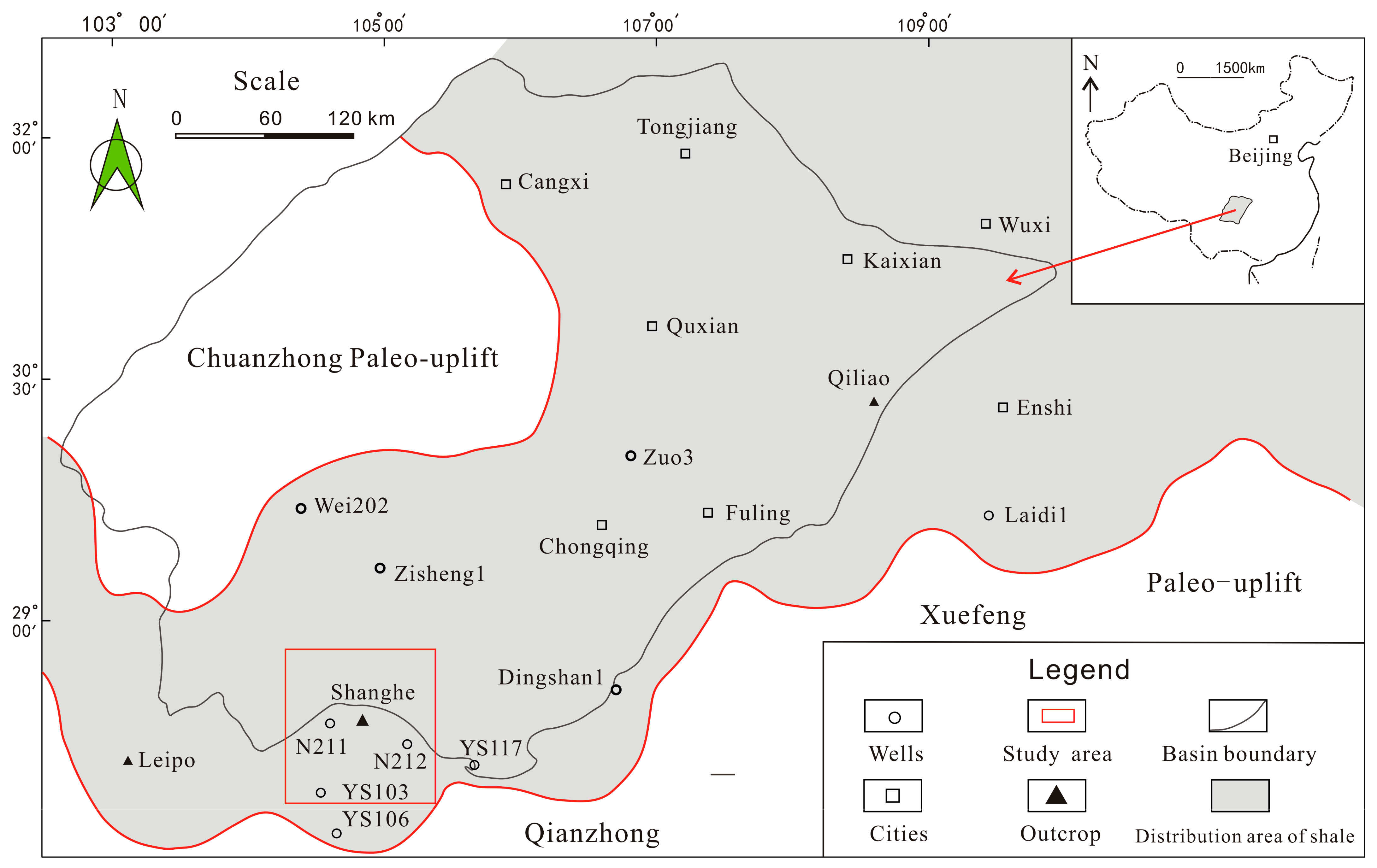

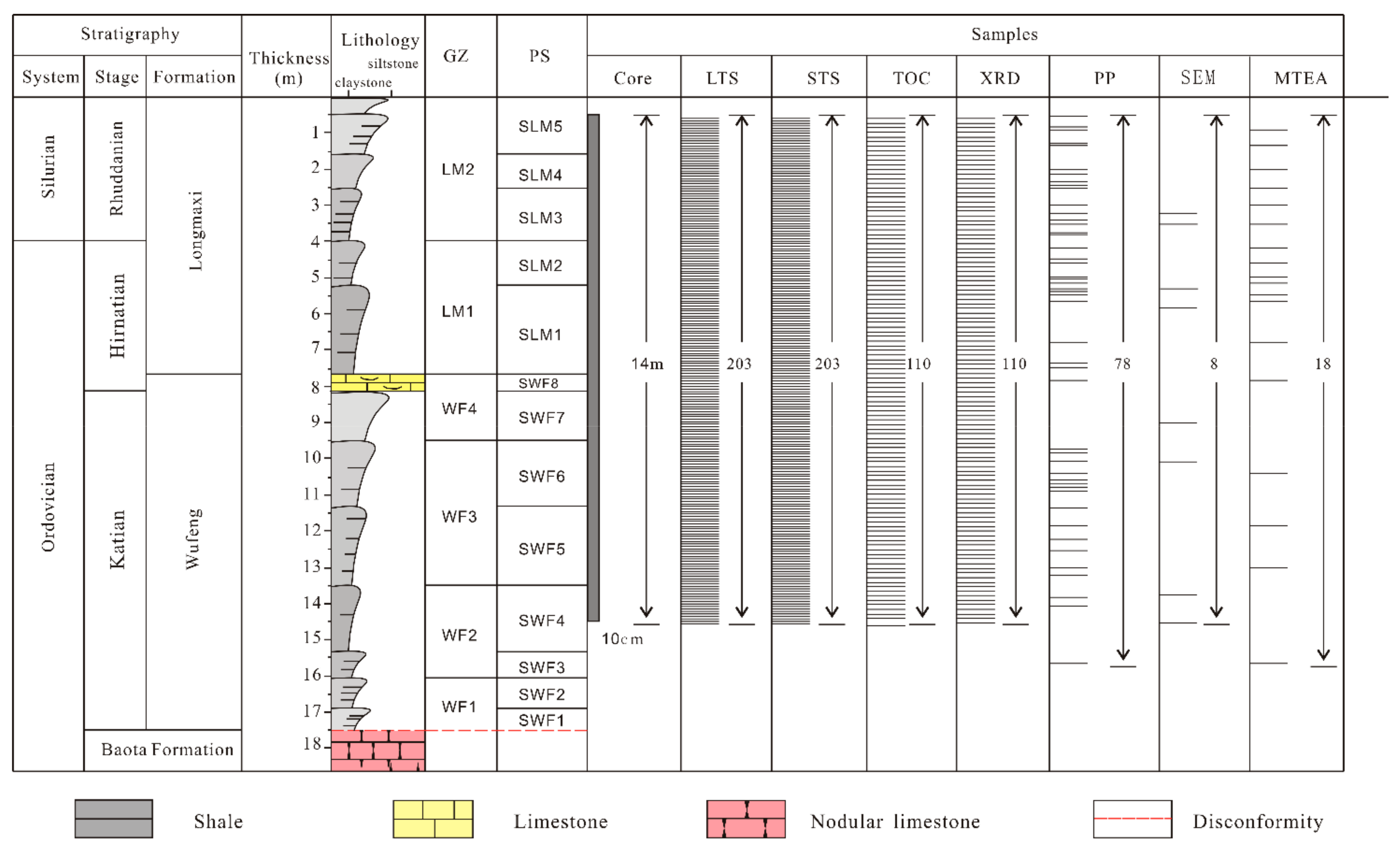
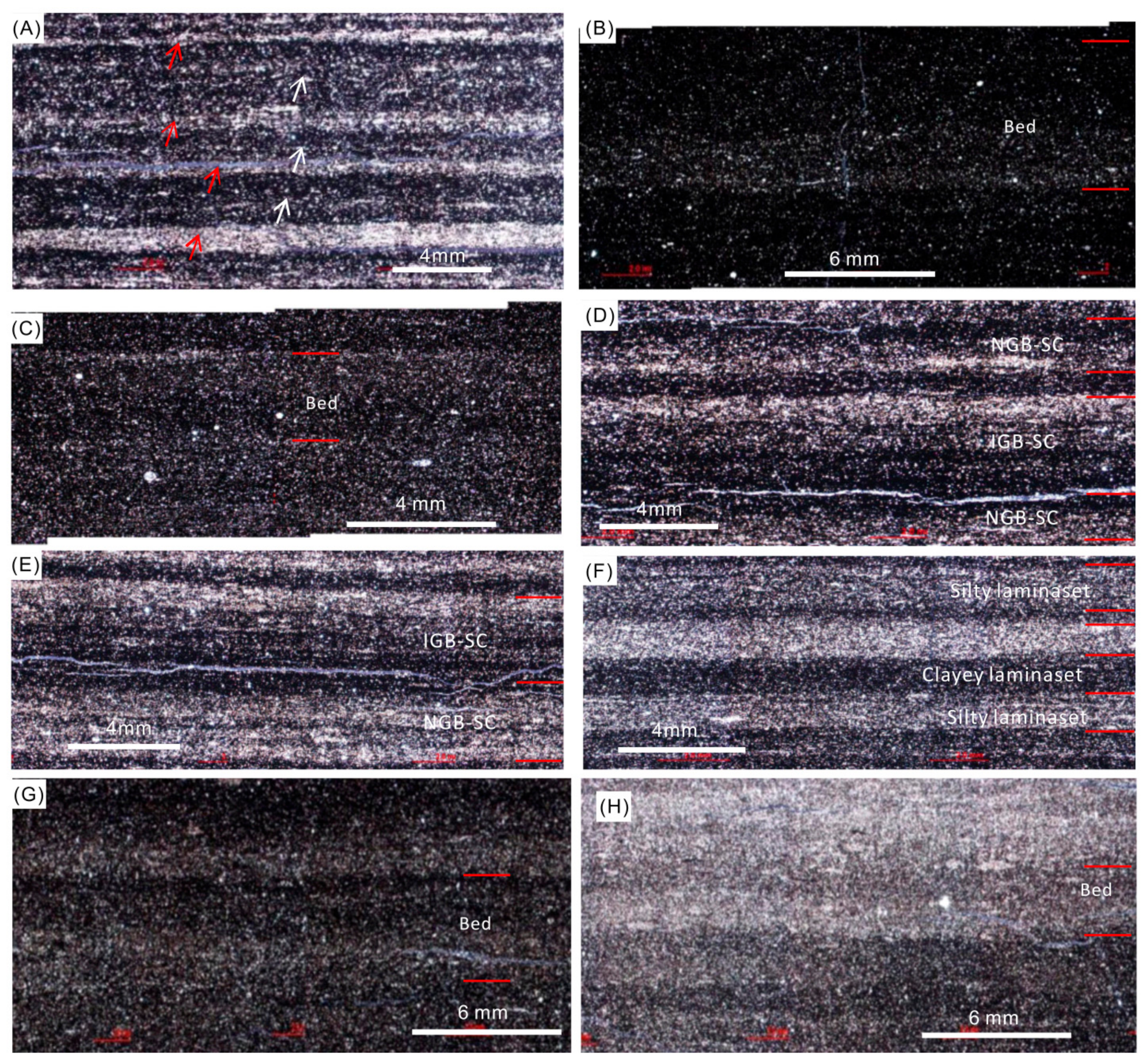
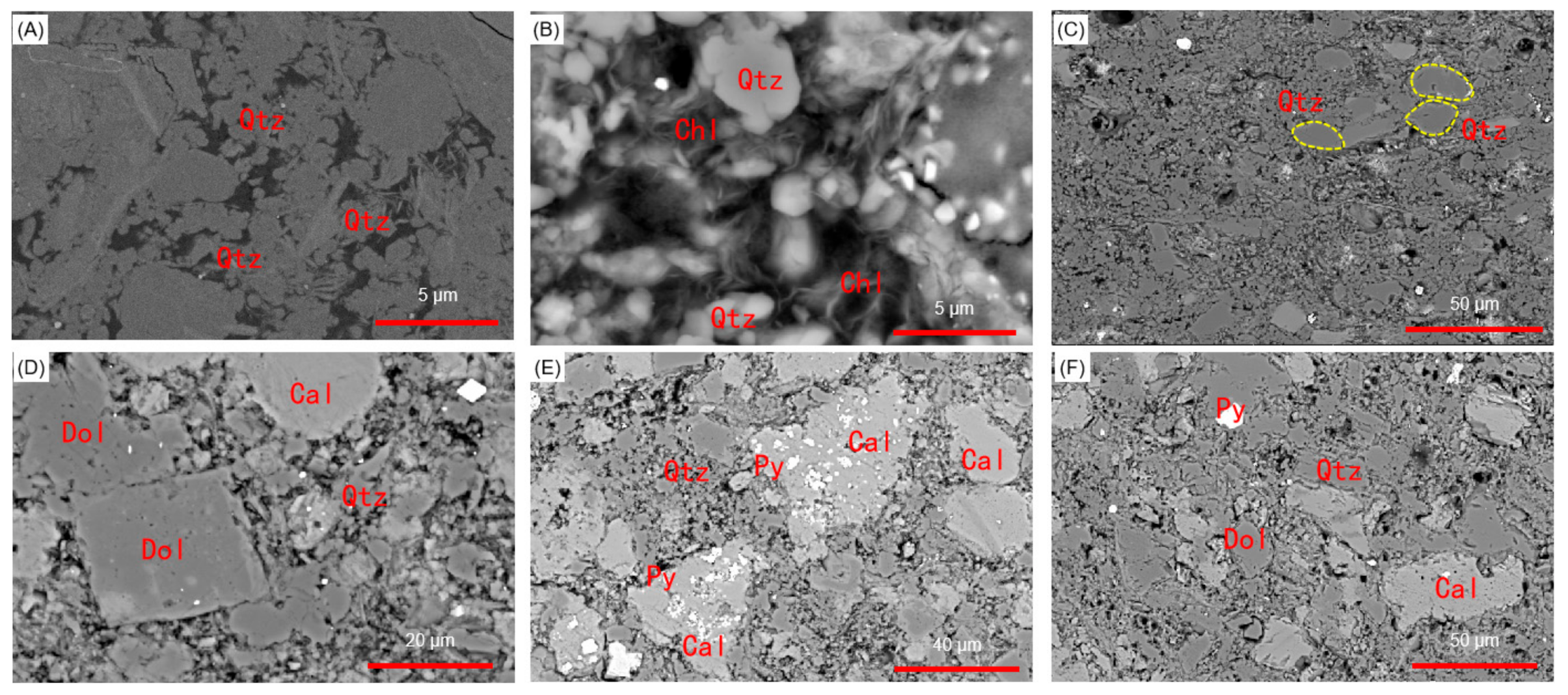
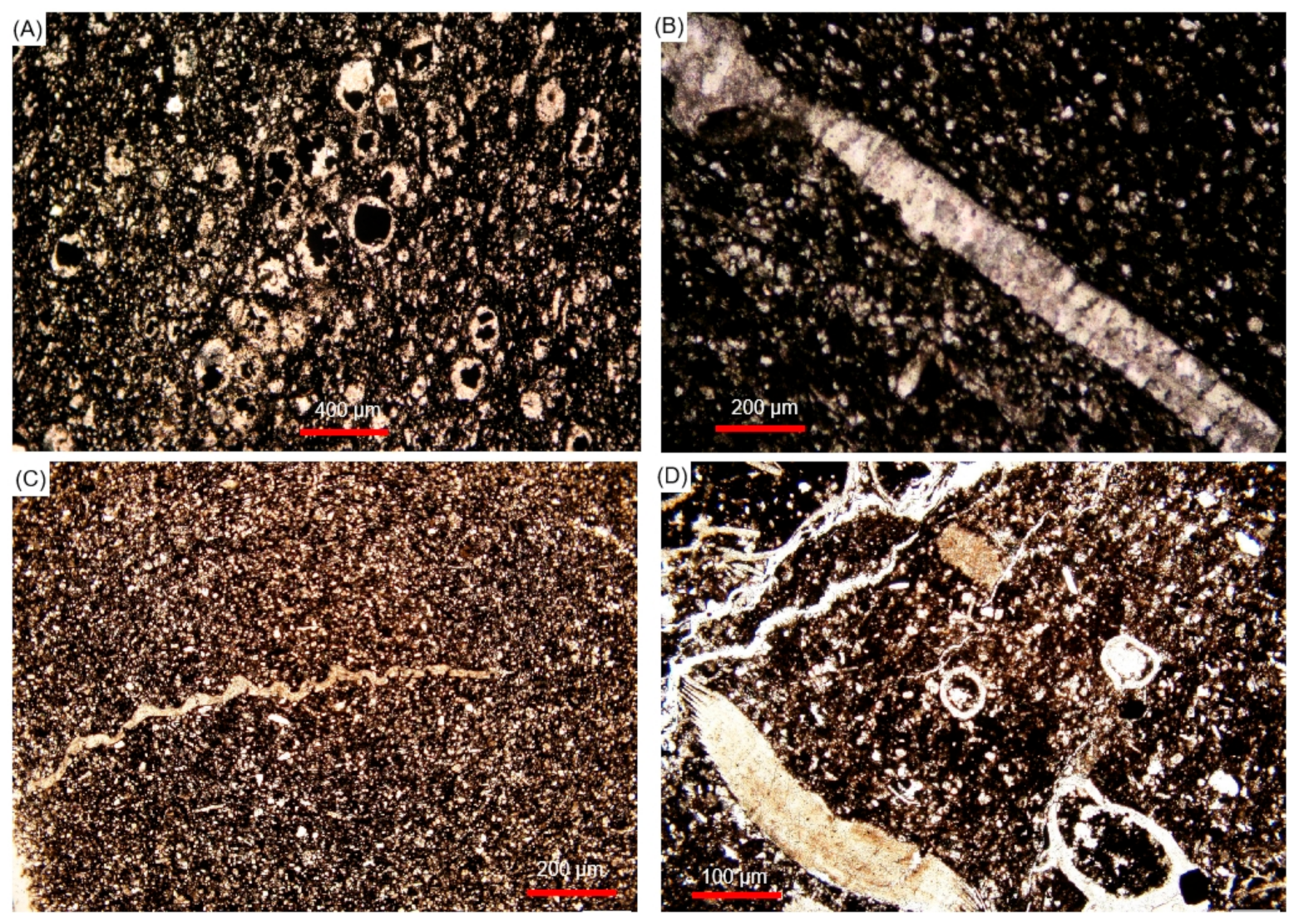
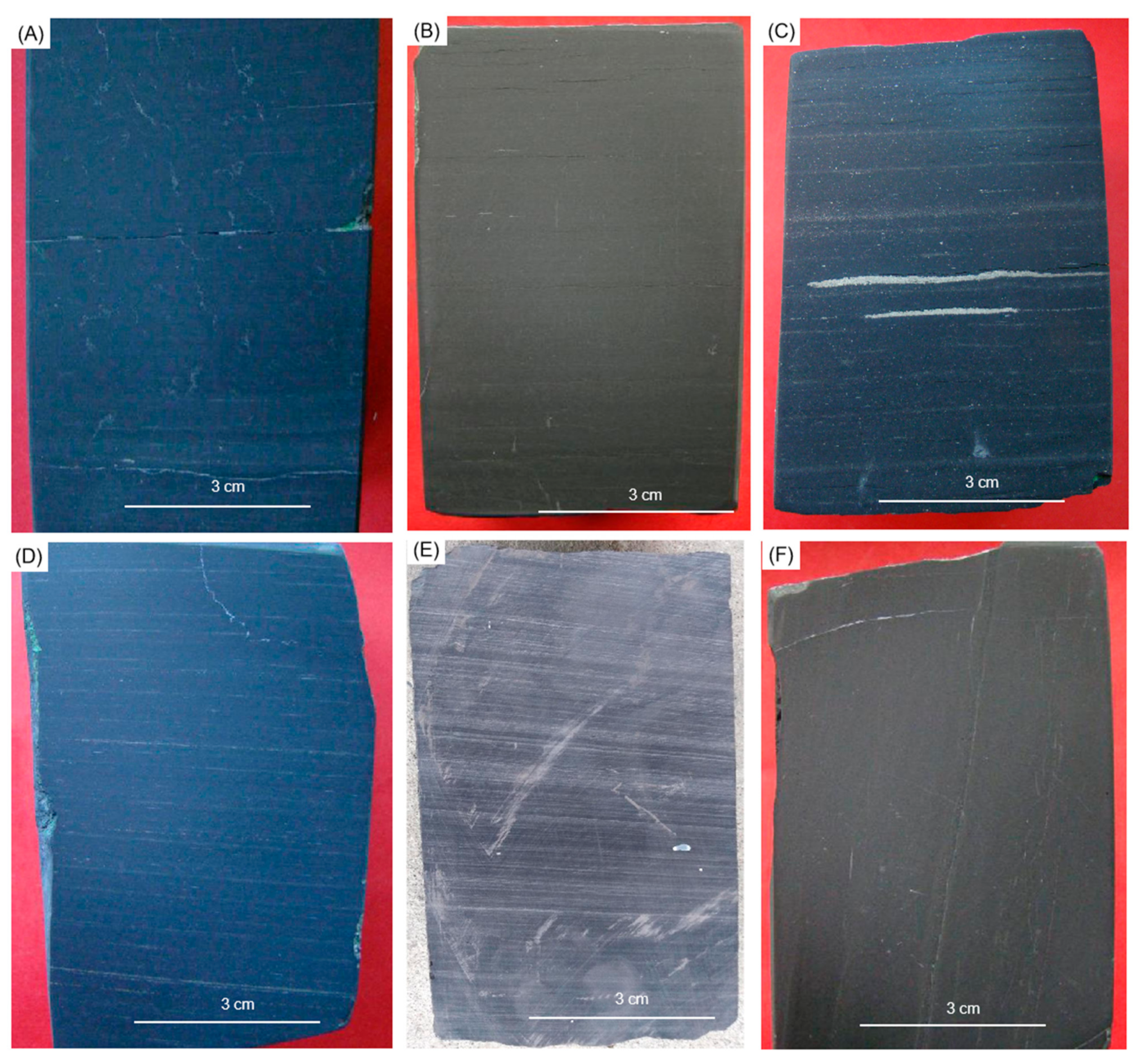
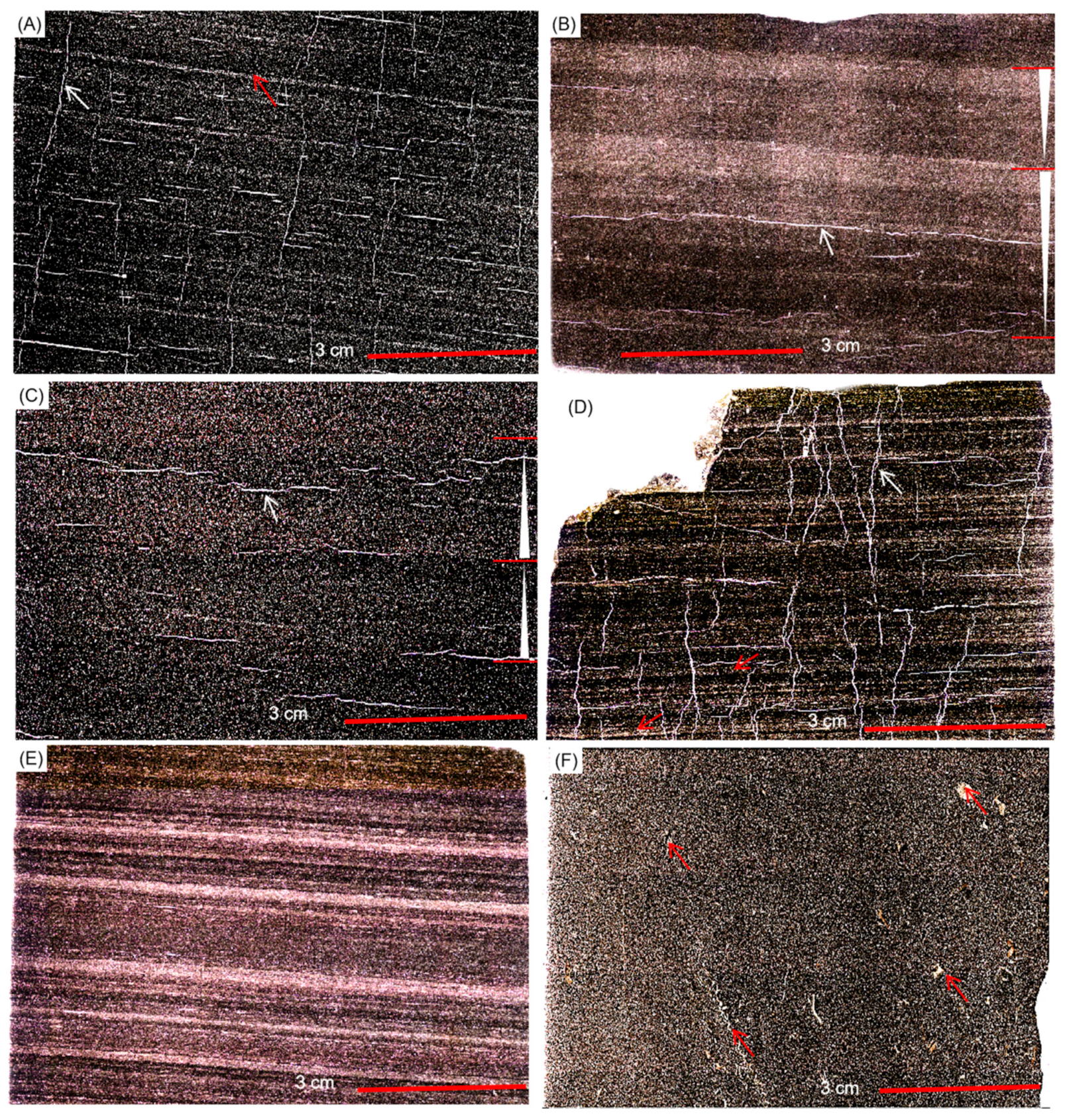
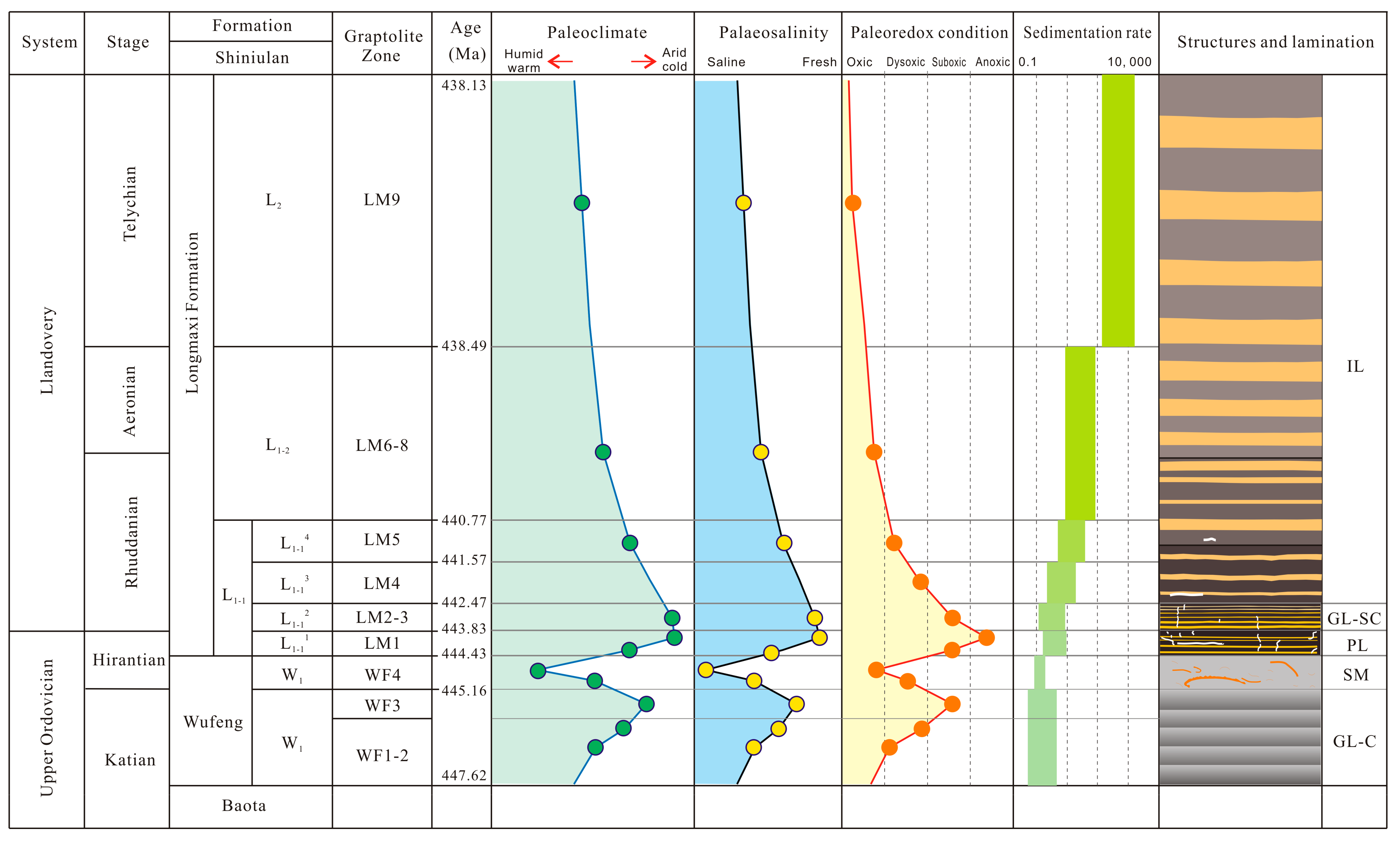
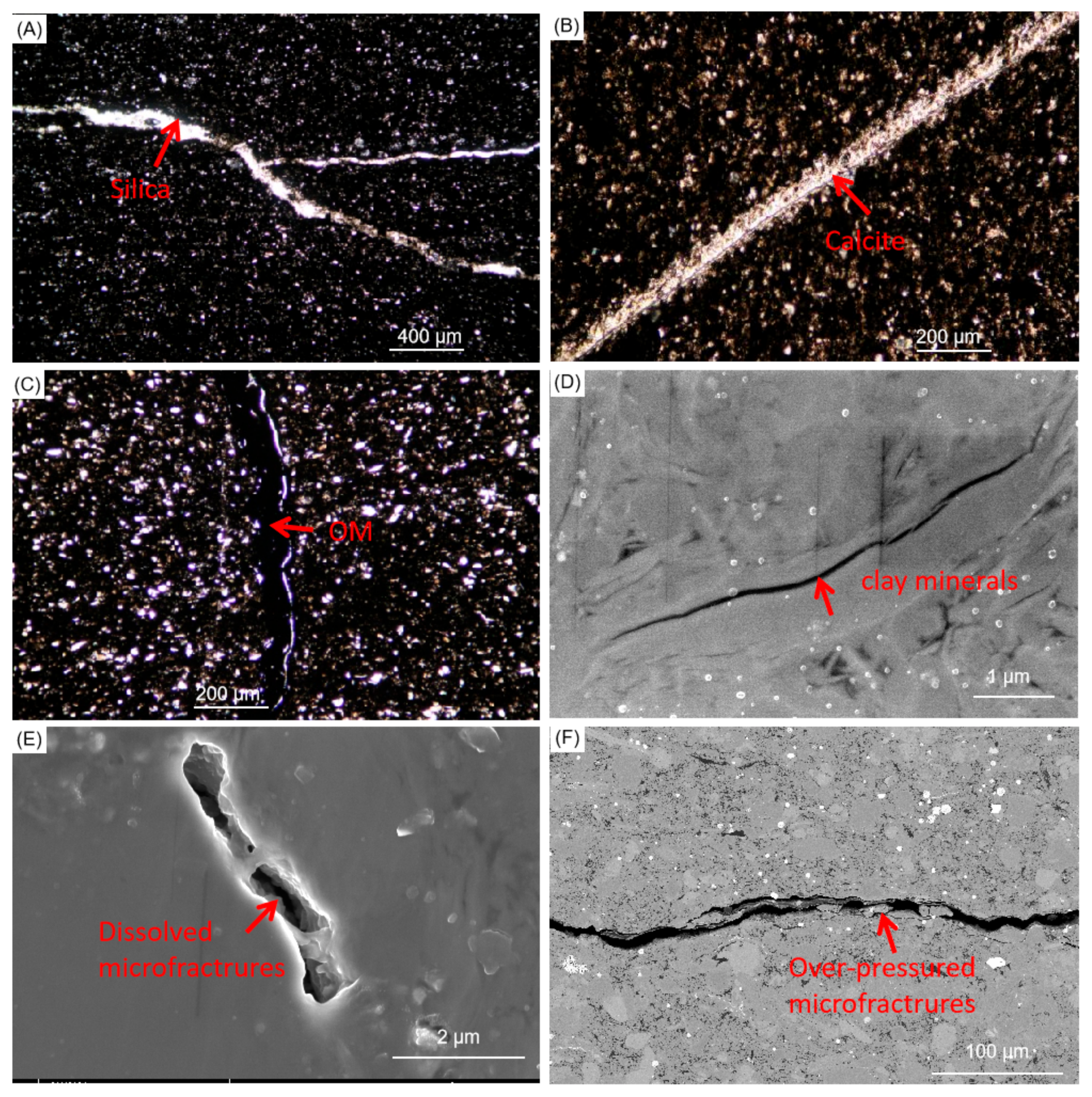
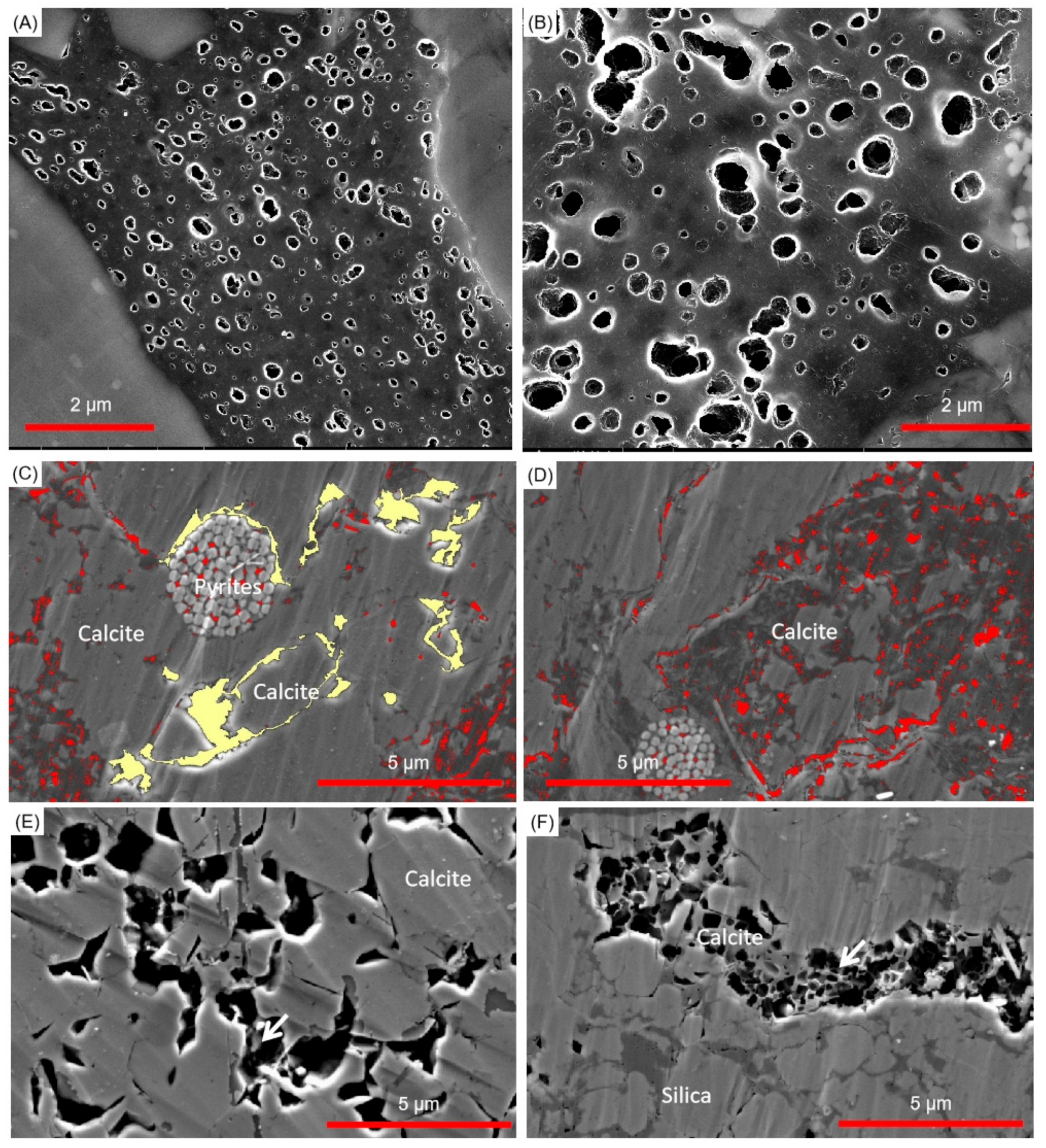
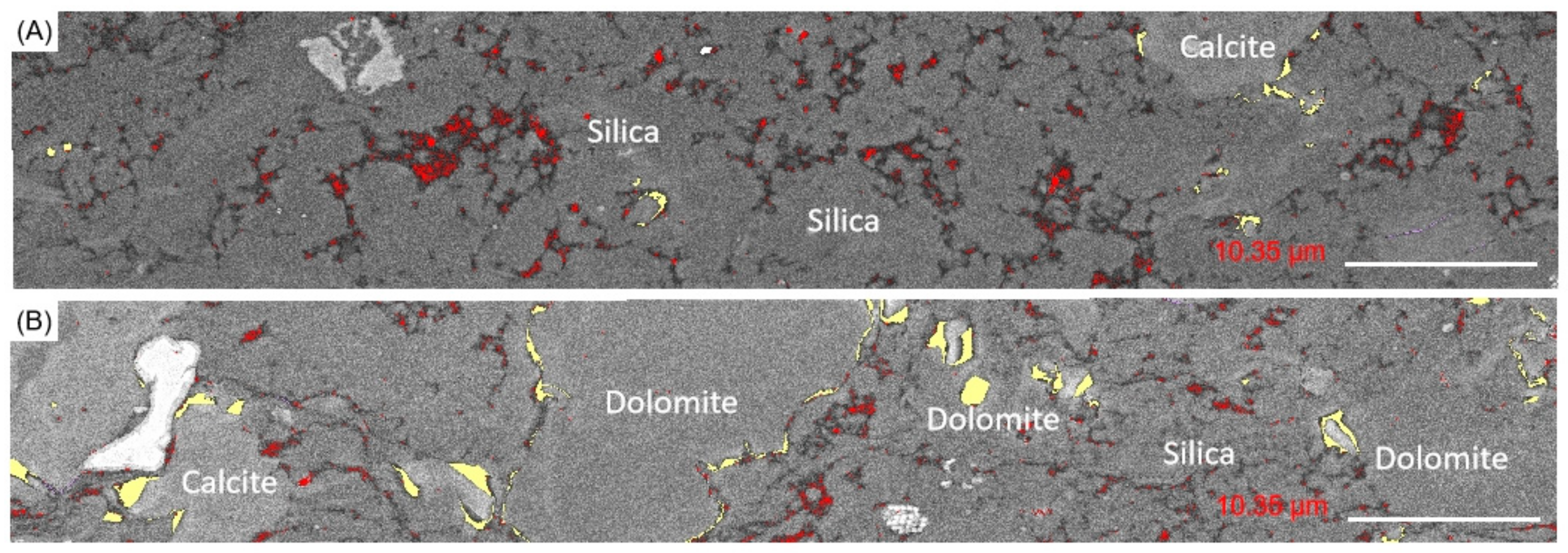
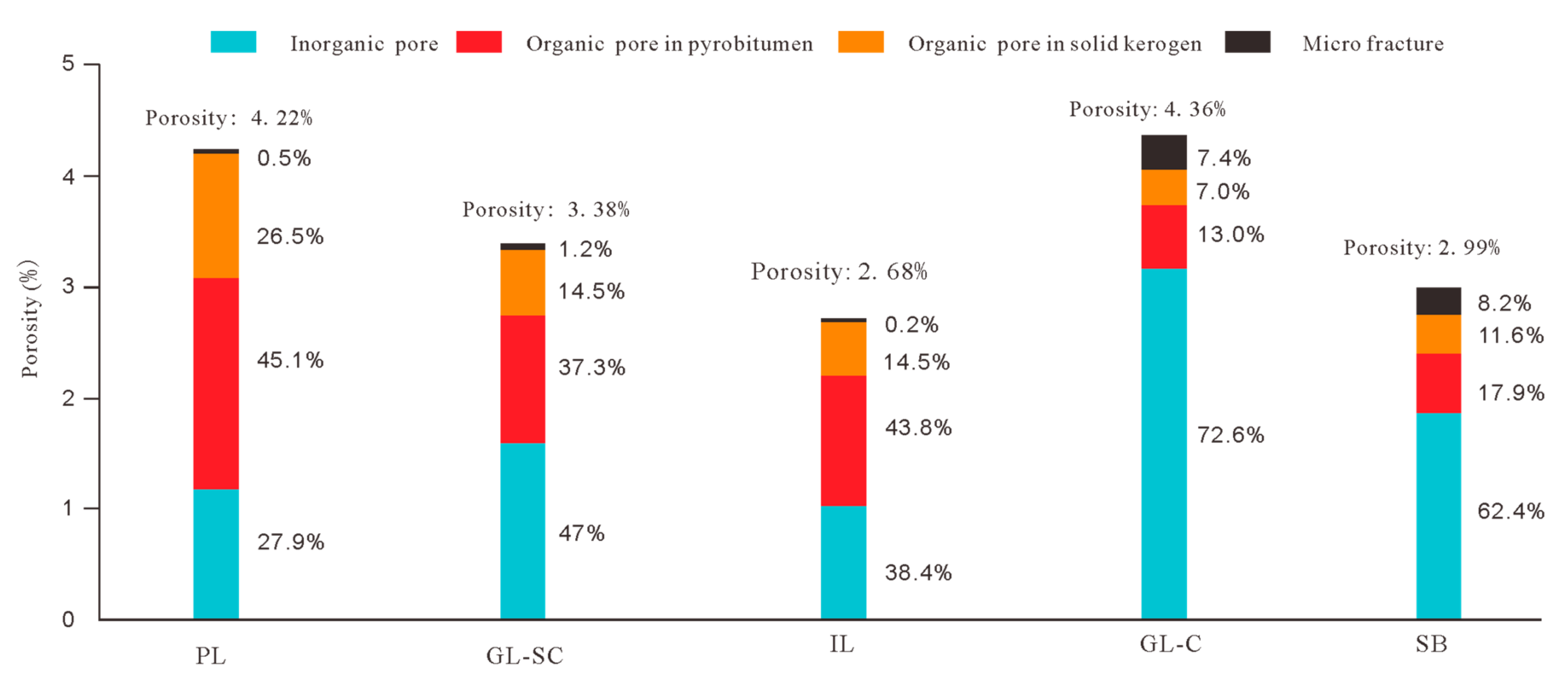
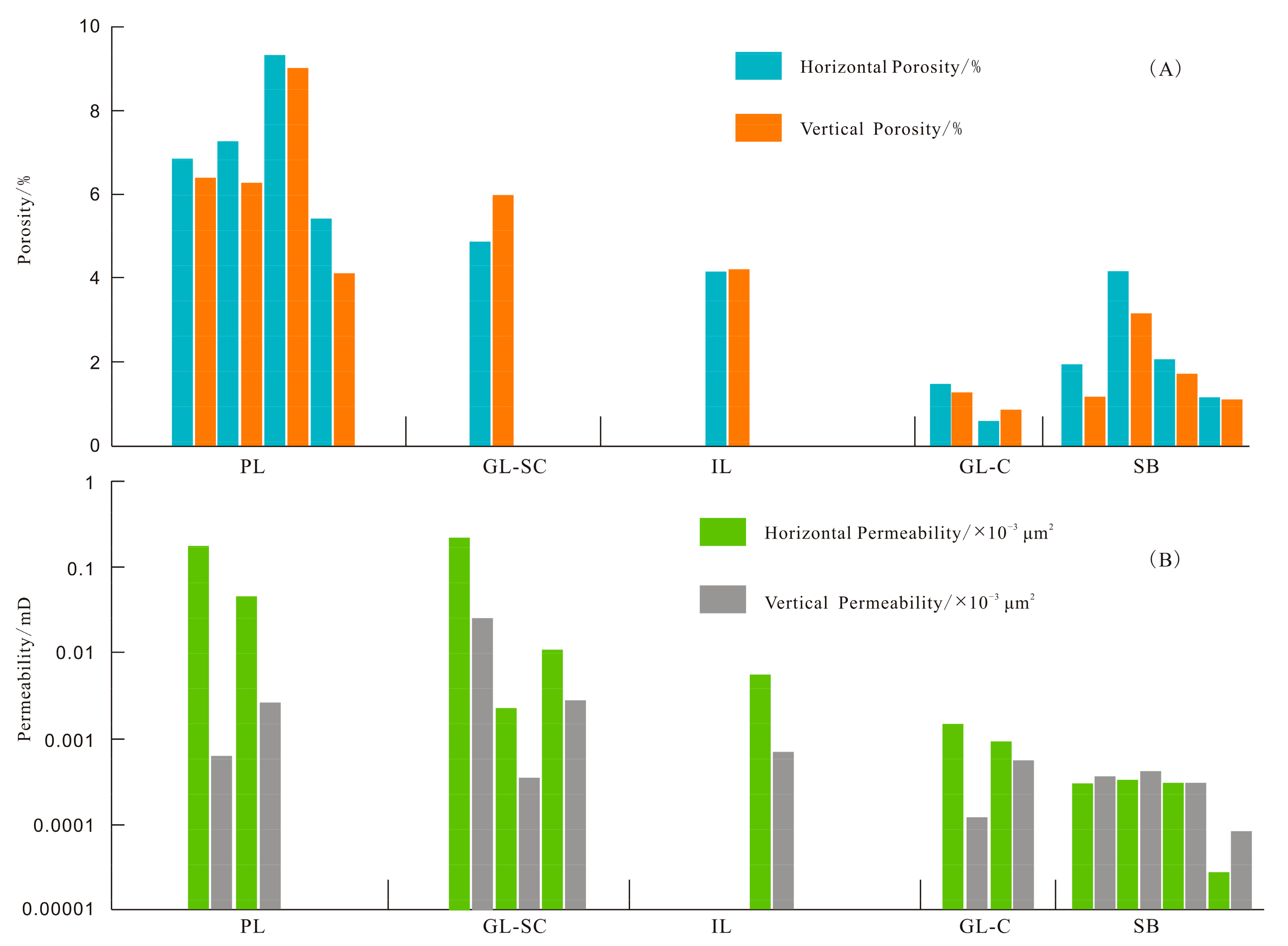
| Layering and Depositional Structures | Description | |||
|---|---|---|---|---|
| Layering | Laminae | Clayey laminae | A layer constructed mainly by claystone dominated by quartz, OM, clay minerals, dolomite, calcite, pyrite, and others | |
| Silty laminae | A layer constructed mainly by siltstone dominated by dolomite, calcite, quartz, pyrite, and OM | |||
| Laminaset | Clayey laminaset | A genetically related succession of clayey lamina bearing lenticular or discontinuous silty lamina | ||
| Silty laminaset | A genetically related succession of silty lamina bearing lenticular or discontinuous clayey lamina | |||
| Bed | NGB-C: Normally graded bed composed of claystone | A genetically related succession of normally graded clayey lamina | ||
| IGB-C: Inversely graded bed composed of claystone | A genetically related succession of inversely graded clayey lamina | |||
| NGB-SC: Normally graded bed composed of siltstone grading into claystone | A genetically related succession of silty laminaset normally grading into clayey laminaset | |||
| IGB-SC: Inversely graded bed composed of claystone grading into siltstone | A genetically related succession of clayey laminaset inversely grading into silty laminaset | |||
| Depositional structures | Parallel lamination | PL: Paper lamination | Shale constructed by clayey laminaset intercalated with linear silty lamina | |
| GL-C: Grading lamination composed of claystone | Shale constructed by NGB-C and/or IGB-C | |||
| GL-SC: Grading lamination composed of siltstone and claystone | Shale constructed by NGB-SC and/or IGB-SC with minor clayey lamina | |||
| IL: Interlaminated lamination composed of siltstone and claystone | Shale constructed by silty lamina with clayey laminaset or silty laminaset with clayey laminaset | |||
| SB: Structureless beds | Shale constructed by siltstone and showing no obvious lamination or bedding | |||
| Depositional Structures | Sample Number | Porosity/% | Permeability/×10−3 μm2 | ||||
|---|---|---|---|---|---|---|---|
| Horizontal | Vertical | H/V | Horizontal | Vertical | H/V | ||
| PL | 8-31-1 | 6.85 | 6.4 | 1.07 | 0.184285 | 0.000655 | 281.35 |
| 9-11-1 | 7.26 | 6.31 | 1.15 | 0.047955 | 0.002761 | 17.39 | |
| 8-10-1 | 9.35 | 9.04 | 1.04 | 0.22354 | 0.025925 | 8.62 | |
| 8-31-2 | 5.43 | 4.13 | 1.31 | 0.002291 | 0.000351 | 6.53 | |
| GL-SC | 9-19-2 | 4.90 | 5.98 | 0.82 | 0.010954 | 0.002876 | 3.81 |
| IL | SLM4-1 | 4.17 | 4.21 | 0.99 | 0.005743 | 0.000714 | 8.04 |
| GL-C | 4-2-1 | 1.47 | 1.27 | 1.16 | 0.00149 | 0.000124 | 12.02 |
| M001 | 0.60 | 0.88 | 0.68 | 0.000931 | 0.000575 | 1.62 | |
| SB | 5-26-2 | 1.93 | 1.18 | 1.68 | 0.000313 | 0.000364 | 0.86 |
| 5-29-2 | 4.16 | 3.17 | 1.32 | 0.000342 | 0.000419 | 0.82 | |
| SWF6-1-2 | 2.08 | 1.73 | 1.22 | 0.0003169 | 0.000316 | 1.00 | |
| 5-34-3 | 1.16 | 1.11 | 1.05 | 0.000028 | 0.000083 | 0.34 | |
Publisher’s Note: MDPI stays neutral with regard to jurisdictional claims in published maps and institutional affiliations. |
© 2022 by the authors. Licensee MDPI, Basel, Switzerland. This article is an open access article distributed under the terms and conditions of the Creative Commons Attribution (CC BY) license (https://creativecommons.org/licenses/by/4.0/).
Share and Cite
Shi, Z.; Zhou, T.; Wang, H.; Sun, S. Depositional Structures and Their Reservoir Characteristics in the Wufeng–Longmaxi Shale in Southern Sichuan Basin, China. Energies 2022, 15, 1618. https://doi.org/10.3390/en15051618
Shi Z, Zhou T, Wang H, Sun S. Depositional Structures and Their Reservoir Characteristics in the Wufeng–Longmaxi Shale in Southern Sichuan Basin, China. Energies. 2022; 15(5):1618. https://doi.org/10.3390/en15051618
Chicago/Turabian StyleShi, Zhensheng, Tianqi Zhou, Hongyan Wang, and Shasha Sun. 2022. "Depositional Structures and Their Reservoir Characteristics in the Wufeng–Longmaxi Shale in Southern Sichuan Basin, China" Energies 15, no. 5: 1618. https://doi.org/10.3390/en15051618
APA StyleShi, Z., Zhou, T., Wang, H., & Sun, S. (2022). Depositional Structures and Their Reservoir Characteristics in the Wufeng–Longmaxi Shale in Southern Sichuan Basin, China. Energies, 15(5), 1618. https://doi.org/10.3390/en15051618








